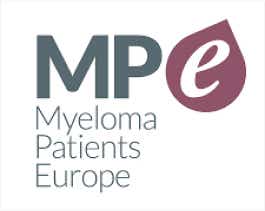Managing MM

Managing multiple myeloma
Multiple myeloma can have a significant impact on your life – from both a physical and emotional perspective. What symptoms do you get? How can you relieve them? How do you handle these new emotions? How can your friends and family help? In this section, you will find practical tips and advice to help you cope with the disease and its symptoms.
Making the most of your appointments

Before your appointments:
- Write down any questions you have as you think of them and take them with you to your appointment.
- Make sure you share your questions with your doctor at the start of your appointment. Don’t wait until the end, when the doctor has run out of time.
- You could ask a family member or friend to come with you to your next appointment. Perhaps they can take notes while you talk to the doctor.

During your appointments:
- It can often be difficult to remember everything that is said during an appointment. You might want to write down what your doctor says so you can refer to your notes afterwards, or even record the appointment (with your doctor’s permission).
- You might not know all of the medical terms mentioned during your consultation or treatment. If there’s a word you have not heard of before, ask the doctor or nurse to explain it.
Getting familiar with your healthcare team

When you were diagnosed with multiple myeloma, you might have felt like you were alone, but apart from your family and friends, there is also a team of healthcare professionals who are with you every step of the way, in addition to patient advocacy groups who are always here to help; find out more about these below.
Your multiple myeloma care team is known as 'multidisciplinary' because it includes specialists from different areas of medicine working together for your wellbeing. Understanding their roles and responsibilities may help you prepare specific questions you might want to ask during your treatment visits.
Below is a list of healthcare professionals you’re likely to speak with at some stage in your treatment journey. Click to expand for more information on each.
Primary care physician – your General Practitioner (GP)
Your GP was probably the first person you saw when you became ill. Even after your treatment gets under way, your GP may still be the first person you contact for any healthcare issues.
Oncologist and haematologist
Your GP will have referred you to a specialist in multiple myeloma who is either a medical oncologist or a haematologist. Oncologists are trained in the diagnosis and treatment of cancer, while haematologists are experts in diseases that affect the blood.
Radiation oncologist
You may be referred to a radiation oncologist. This is a physician who specialises in treating cancer with radiation therapy.
Orthopaedic surgeon
An orthopaedic surgeon is an expert in bone surgery and will be there to address any orthopaedic (bone-related) problems that you may have during treatment.
Oncology nurse
An oncology nurse is specially trained to work closely with your haematologist or oncologist to coordinate your care and give treatments.
Social worker
Social workers can help you with emotional, physical or financial problems. They can also advise you about any practical support services that maybe available.
Psychiatrists and psychologists
Living with multiple myeloma can be tough and some might find it challenging at an emotional level. You may benefit from speaking with a professional counsellor, like a psychiatrist or a psychologist.*
*What is the difference between a psychiatrist and a psychologist?
A psychiatrist is a medical doctor trained to diagnose and manage mental illness. Psychiatrists can prescribe medication, such as antidepressants, if you need them.
A psychologist is not a medical doctor, but someone who is well trained in counselling and human psychology. They cannot prescribe medication.
Dietitians and nutritionists
Multiple myeloma and its treatment can make eating difficult. A registered dietitian can help you to maintain the healthiest diet possible throughout treatment. Your dietitian will be able to suggest foods or drinks to help if you are experiencing:
• nausea
• vomiting
• loss of appetite
• a dry or sore mouth
Pharmacist
As well as dispensing medications, your pharmacist is a valuable source of information. They can answer questions about:
• when and how to take medicines
• what side effects to expect
• what to do if you have side effects
Dentist
Since myeloma affects your bones, your jaw and teeth may be affected too. If your dentist is not already familiar with the special needs of people with multiple myeloma, you should tell them about your medication or pass on the details of your specialist so that any necessary treatments can be planned properly.
Managing Symptoms
Because multiple myeloma grows slowly, about one-third of those with it do not show symptoms, and those who do will likely not show any for some time. However, as multiple myeloma develops, symptoms can get worse and you are more likely to experience them.
Below are a list of some of the most commonly experienced symptoms. If any of these affect you, click on them to expand for more information on how to manage them.
Remember though, always talk to your doctor or nurse to get advice if you are experiencing symptoms, especially if there has been a sudden change.
Bone pain
You may experience bone pain, which can feel like a dull, constant pain, usually in your back, ribs and hips.
How to manage bone pain
- Use hot water bottles or ice packs
- Find a comfortable position when you are sitting or lying down so you feel as little pain as possible. Use pillows to prop you up in bed
- Try to keep your anxiety and stress levels as low as possible, because these can make pain worse. Take time to talk about your worries with your family and friends
- If you are in pain, a gentle massage can help you relax. See an experienced massage therapist and explain your situation to them. Always check with your haematologist before seeking complementary therapy such as this
- Try to rest and sleep as much as you need to
- Make sure you always discuss bone pain symptoms with your doctor or nurse
- You may be recommended or prescribed pain killers, take these only as per the advice of your healthcare professional. If a healthcare professional other than your haematologist is prescribing you pain killers, make sure he is aware of any other treatment you’re taking first
Nerve damage
Nerve damage (or ‘peripheral neuropathy’) can cause tingling, numbness or pain. This can be caused by multiple myeloma and it can also be a side effect of some treatments.
How to manage symptoms of nerve damage
- Keep your hands and feet warm
- Use light bed covers. This reduces the pressure on your legs and makes it easier to move in bed
- Be careful when using sharp objects such as knives or scissors. Numbness can affect your grip
- Wear appropriate shoes to avoid pain and check your feet every day for redness or blisters
- Check the temperature of your bath or shower water before you get in to avoid scalding yourself. Use a bath thermometer or ask someone else to check the temperature for you
- Do light physical exercise, such as walking, to improve your blood circulation
- Stop smoking. Nicotine and other chemicals in cigarettes (including e-cigarettes) can damage blood vessels, making it harder to manage your symptoms. Smoking can also delay healing after treatment. Talk to your healthcare team for information about support available to help you quit
- Think about using mobility aids, such as a walking stick or frame, to help with your everyday tasks
Fatigue
Fatigue is a common symptom of multiple myeloma and can also be a side effect of some treatments. Myeloma can also cause a reduction in the number of red blood cells in your body, which can lead to anaemia (a lack of iron caused by having fewer red blood cells). Extreme fatigue is a symptom of anaemia.
How to manage fatigue
- Eat a balanced diet and choose foods that are rich in iron
- Drink plenty of water
- If you have problems eating, ask your doctor to refer you to a dietician
- Get enough sleep and establish a routine by going to bed and getting up at the same time every day
- Do some light physical exercise every day; this can really help boost your energy levels
- Plan some daily activities and also give yourself time to rest during the day
Increased risk of infection
Multiple myeloma affects the immune system (our body’s natural defence against infections and illnesses). Some medicines used to treat multiple myeloma can also weaken the immune system. This means you can become particularly sensitive to infections.
An infection generally shows up as a fever (over 38°C), but symptoms can also include:
- Feeling unwell
- Chills
- Coughing
- Sore throat
- Diarrhoea
- Redness or swelling around a wound
If you have any signs of infection, contact your nurse or doctor immediately.
How to reduce the risk of infection
- Wash your hands regularly, and try not to touch your mouth, nose and eyes
- When you go out, make sure you always take some alcohol gel-based hand sanitizer to keep your hands clean
- Try to stay away from people who have recently had (or still have) a contagious illness like chickenpox or the flu
Kidney problems
Multiple myeloma itself is the main cause of impaired kidney function. Some medicines can also affect the kidneys. Symptoms you may experience associated with kidney problems include a persistent feeling of thirst, nausea and needing to urinate frequently.
How to protect your kidneys
- Make sure you stay hydrated and try to drink 2–3 litres of water a day (unless your doctor has advised otherwise)
- If you are having dialysis, tell your doctor and nurse
Stay healthy, stay informed
It’s only natural to feel uncertainty and have negative emotions after you are diagnosed with multiple myeloma. You may feel confused, anxious, depressed or even angry, and may want to withdraw from people. This does not always happen, but feelings like these are only human. Your situation is complicated, and everyone reacts in their own way.
If you are anxious about your illness or treatment, do not hesitate to talk to any of the healthcare professionals taking care of you. As the saying goes: knowledge is power. The more information you have, the more in control you will feel. And you will then be in a better position to make informed decisions.
Tips to help you in the adjustment period

Keep a diary
Keeping a diary helps you get a handle on your feelings. It's also another place where you can make a note of any symptoms or side effects you may be experiencing.
Reach out to support groups
You can join a support group to share your experiences with people in the same situation. Click here for more details.

Talk to family and friends
They can be a fantastic source of support, both practical and emotional.
Talk openly
Be frank with your loved ones about your illness, treatment and worries. The better they understand, the more they can support you.


Ask for help
Living with multiple myeloma and managing its various symptoms can be an exhausting experience. Don’t be afraid to ask family, friends, or support groups for help.
Talk to your doctor and nurse
They are used to the questions and doubts that you have. They can also be a real source of support.


Set your own pace and goals
Take each day as it comes. Focus on what you can control here and now, and on your current quality of life rather than on unknowns.
On good days you can set small goals or realistic tasks: going for a walk, calling a friend for a chat. Make a list of simple tasks to keep you occupied. Each day, you can tick off what you have managed to do. You can save what you were not able to do for tomorrow. Above all, try not to make too many changes to your life at the same time.
Watch out for symptoms of depression
It is important to recognise when your stress or negative feelings are turning into depression. If this happens to you, you must talk about it with your doctor or nurse. They may refer you to a psychologist or psychiatrist who can help you.
Some signs of depression are:
- You find it hard to sleep
- You are unable to concentrate
- You lose interest in most activities
- You regularly feel low
If you’re depressed, let people know why. Some friends or family members may not understand why you feel depressed. Keep being open and honest with them and encourage them to take the same approach with you.

For more in-depth detail on symptoms and lifestyle adjustments, download the ‘Stay healthy, stay informed’ booklet.


Patient advocacy groups
This website is developed exclusively by Janssen Pharmaceutica NV. Please note that the patient advocacy groups listed below are an additional and independent source of information you might find useful. These groups were not involved with the creation of this website and do not endorse its content in any way.

Pan-European: Myeloma Patients Europe (MPE)
MPE’s mission is to provide education, information and support to member groups and to advocate at European, national and local levels for the best possible research and equal access to the best possible treatment and care. https://www.mpeurope.org/

Global: The International Myeloma Foundation (IMF)
The IMF is dedicated to improving the quality of life of myeloma patients while working toward prevention and a cure through their four founding principles: Research, Education, Support, and Advocacy.